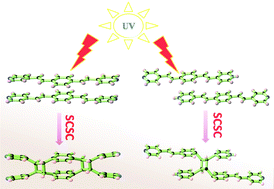Modulating the regioselectivity of solid-state photodimerization in coordination polymer crystals†
Abstract
Coordination polymers [Cd(1,4-bpeb)(L1)] (1), [Zn2(1,4-bpeb)2(L2)2(SO42−)2] (2) and [Cd(1,4-bpeb)(L3)] (H2O) (3) (H2L1, 3-[2-(3-hydroxy-phenoxymethyl)-benzyloxy]-benzoic acid; HL2, 1H-Indazole-3-carboxylic acid; H3L3, benzene-1,2,3-tricarboxylic acid; 1,4-bpeb, 1,4-bis[2-(4-pyridyl)vinyl]benzene have been synthesized under solvothermal conditions. Complexes 1–3 underwent photodimerization in the solid-state to give quantitative yields of single isomeric products. The choice of carboxyl ligands L and metal center determined the arrangement of 1,4-bpeb ligands, which in turn directed the regiochemistry of the final photoproducts. The solid-state network structures of cadmium based 1 and 3 had 1,4-bpeb pairs aligned face-to-face with both C![[double bond, length as m-dash]](https://www.rsc.org/images/entities/char_e001.gif) C centres in each ligand at an appropriate distance and alignment for photodimerization to give the corresponding para-[2.2]cyclophane (pCP) exclusively. By contrast, compound 2 possessed dinuclear (ZnSO4)2 metallocycles that positioned the 1,4-bpeb “arms” face-to-face, but with C
C centres in each ligand at an appropriate distance and alignment for photodimerization to give the corresponding para-[2.2]cyclophane (pCP) exclusively. By contrast, compound 2 possessed dinuclear (ZnSO4)2 metallocycles that positioned the 1,4-bpeb “arms” face-to-face, but with C![[double bond, length as m-dash]](https://www.rsc.org/images/entities/char_e001.gif) C centres offset at an appropriate distance for only one pair to undergo [2 + 2] cycloaddition to yield a single stereoisomer of the monocyclobutane photo-product bpbpvpcb. This work highlights crystal engineering design principles that can be used to facilitate regio- and stereospecificity in solid-state transformations.
C centres offset at an appropriate distance for only one pair to undergo [2 + 2] cycloaddition to yield a single stereoisomer of the monocyclobutane photo-product bpbpvpcb. This work highlights crystal engineering design principles that can be used to facilitate regio- and stereospecificity in solid-state transformations.



 Please wait while we load your content...
Please wait while we load your content...